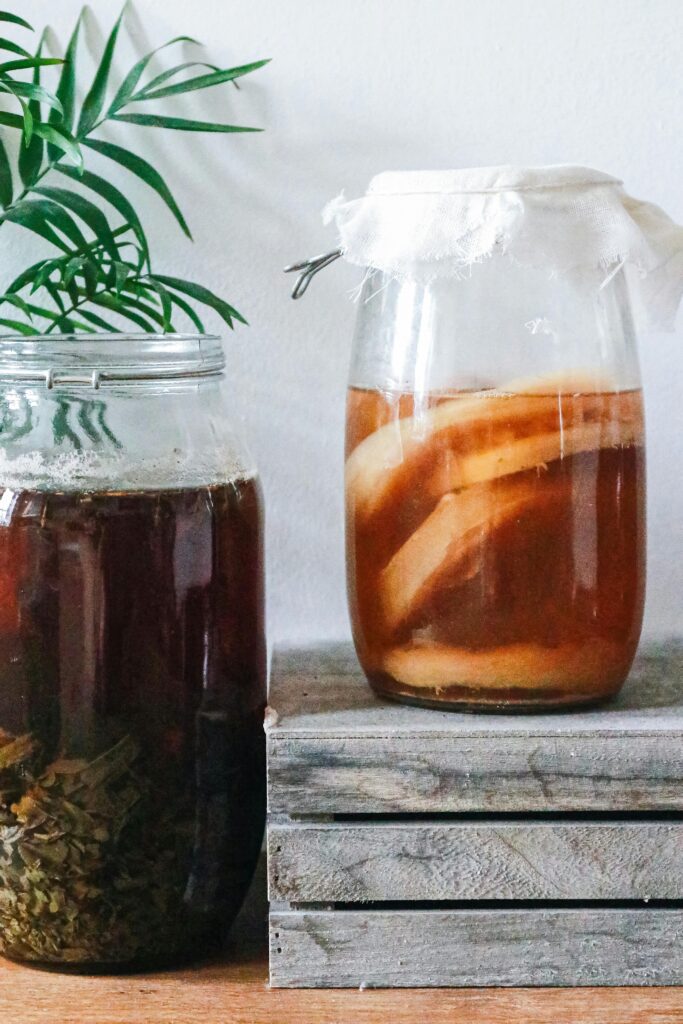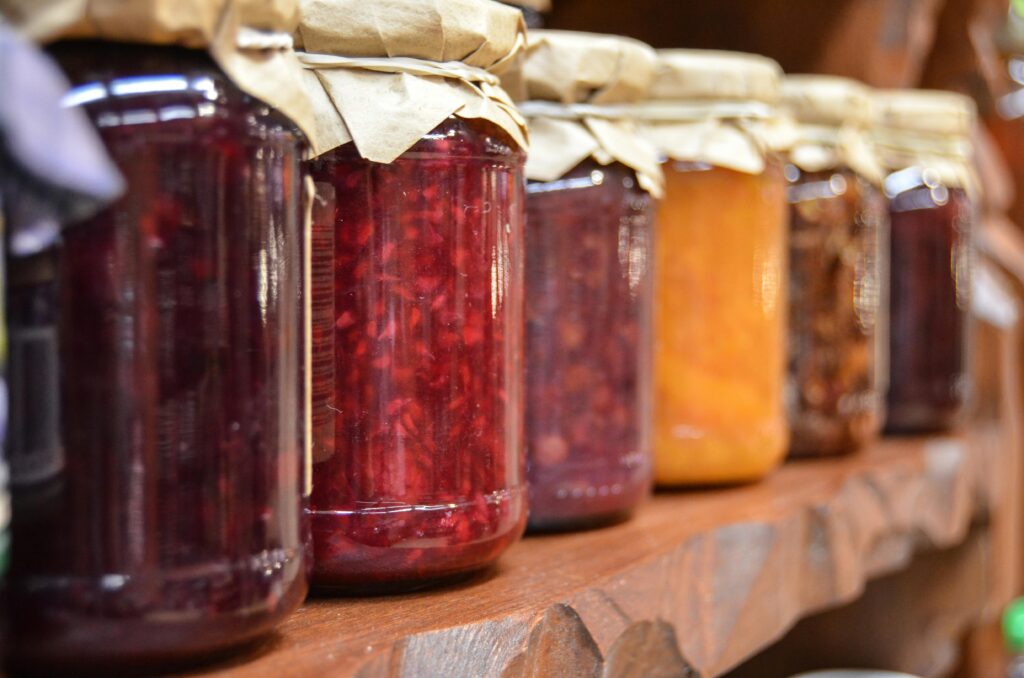The Art of Homemade Kombucha: A Beginner’s Guide
Kombucha, a fermented tea known for its tangy taste and powerful health benefits, has become a staple for wellness enthusiasts everywhere. Packed with probiotics, antioxidants, and a variety of essential nutrients, kombucha can support your gut health, boost your immune system, and even improve mental clarity. If you’ve ever wondered how to make your own batch at home, you’re in the right place. In this beginner’s guide, we’ll walk you through the simple process of brewing kombucha, why it’s beneficial, and how you can enjoy the satisfaction of crafting your own fermented beverage.

What is Kombucha?
Kombucha is a naturally fermented beverage made by fermenting sweetened tea with a symbiotic culture of bacteria and yeast (SCOBY). The fermentation process allows beneficial bacteria (probiotics) to develop, creating a drink that’s not only refreshing but also packed with gut-friendly benefits. Want to make your own SCOBY? Find the full recipe here!
The Benefits of Kombucha
Kombucha is revered for its numerous health benefits, including:
- Gut Health Support: Kombucha is rich in probiotics, which can help balance the gut microbiome, aiding digestion and improving gut health.
- Detoxification: The fermentation process results in organic acids like glucuronic acid, which can help detoxify the liver.
- Immune Boosting: Kombucha is high in antioxidants, which can protect your cells from oxidative damage and support your immune system.
- Mental Clarity: The B-vitamins and enzymes in kombucha can help enhance cognitive function and reduce brain fog.

Ingredients for Brewing Kombucha
Before you start brewing, you’ll need the following ingredients and supplies:
| Ingredient | Amount | Purpose |
|---|---|---|
| Tea (black or green) | 8 bags or 1 tablespoon loose | The base of kombucha, providing flavor and nutrients |
| Sugar (organic white sugar) | 1 cup | Feeds the yeast and bacteria during fermentation |
| Water | 4 cups | To brew the tea |
| SCOBY (Symbiotic Culture of Bacteria and Yeast) Want to make your own SCOBY? Find the full recipe here! | 1 SCOBY | The culture that ferments the tea, turning it into kombucha |
| Starter tea (from a previous batch or store-bought kombucha) | 1-2 cups | Helps kick-start fermentation by lowering pH |
Steps to Brewing Kombucha at Home

Follow this easy-to-follow guide to brew your own kombucha at home.
Step 1: Brew the Tea
- Boil Water: In a large pot, bring 4 cups of water to a boil.
- Steep the Tea: Add 8 tea bags or 1 tablespoon of loose leaf tea to the hot water. Let it steep for 5-10 minutes, depending on your desired tea strength.
- Add Sugar: Stir in 1 cup of sugar while the tea is still hot, dissolving it completely.
Step 2: Cool the Tea
Once the tea has steeped and the sugar has dissolved, remove the tea bags or strain out the loose leaves. Allow the tea to cool to room temperature. This step is crucial to avoid harming the SCOBY, which thrives in a warm but not hot environment.
Step 3: Add the SCOBY and Starter Tea
- Add Starter Tea: Pour 1-2 cups of starter tea (from a previous batch of kombucha or store-bought kombucha) into the cooled tea. This helps balance the pH and promotes fermentation.
- Introduce the SCOBY: Gently place the SCOBY into the jar with the tea mixture. The SCOBY may sink at first but will eventually float to the surface as fermentation progresses.
Step 4: Fermentation
- Cover the Jar: Use a clean cloth or paper towel to cover the jar, securing it with a rubber band. This allows airflow while keeping dust and debris out.
- Let It Ferment: Place the jar in a warm, dark place, like a kitchen cupboard, and let it ferment for 7-14 days. The fermentation time depends on the temperature of the room and your taste preference. The longer it ferments, the more acidic and less sweet it becomes.
Step 5: Taste and Bottle
After the fermentation period, taste your kombucha. If it’s to your liking (slightly sweet and tangy), it’s time to bottle. If you prefer a stronger flavor, let it ferment for a few more days.
Bottling Process:
- Remove the SCOBY and set it aside for your next batch of kombucha.
- Pour the kombucha into glass bottles, leaving some room at the top. If you’d like, add fruit or herbs for flavor during the second fermentation (e.g., ginger, berries, or mint).
- Seal the bottles and leave them at room temperature for 1-3 days for natural carbonation.
Step 6: Refrigerate and Enjoy!
Once your kombucha is carbonated to your liking, transfer it to the fridge to stop the fermentation process. Enjoy your homemade, probiotic-rich kombucha!
Want to make your own SCOBY? Find the full recipe here!

Pro Tips for Successful Kombucha Brewing
- Cleanliness is Key: Make sure everything is thoroughly cleaned and sanitized to avoid contamination.
- Temperature Matters: Keep your kombucha in a warm (but not hot) environment—ideally between 70-85°F (21-29°C).
- Second Fermentation: Experiment with different flavors by adding fruit or herbs during the second fermentation. Common flavoring options include ginger, lemon, berries, and even lavender.
- Taste Test: Kombucha is a personal preference! Taste your kombucha every few days and stop fermenting when it reaches the flavor balance you enjoy.
Troubleshooting Your Kombucha
Even experienced brewers encounter issues. Here are some common problems and solutions:
| Problem | Possible Cause | Solution |
|---|---|---|
| Kombucha is too sweet | Too short of fermentation time | Allow more time for fermentation and taste frequently |
| Mold on the SCOBY | Contamination or improper temperature | Discard the batch, clean all equipment, and start fresh with a healthy SCOBY |
| Kombucha is too vinegary | Fermented for too long | Reduce fermentation time for a sweeter taste |
The Joy of Brewing Kombucha
Making kombucha at home not only provides health benefits but also brings joy and creativity into your kitchen. Each batch is a learning experience, allowing you to experiment with flavors and fermentation times to suit your preferences. Plus, the knowledge that you’re crafting your own gut-friendly beverage adds a personal touch to your wellness journey.
Final Thoughts
Kombucha is more than just a drink—it’s a probiotic powerhouse that can support gut health, detoxification, and overall well-being. By making kombucha at home, you take control of the ingredients, the brewing process, and the flavors, ensuring that every batch is perfectly tailored to your taste.
Citations and References:
- Mandel, K. et al. (2020). “The Effects of Probiotics on Gut Health and Immunity.” Journal of Food Science.
- Muller, M. et al. (2019). “Kombucha: A Review of Its Health Benefits.” Nutrition Journal.
- Mayo Clinic. (2022). “Probiotics: What You Need to Know.”
As an Amazon Affiliate, we earn from qualifying purchases but at no extra cost to you.



